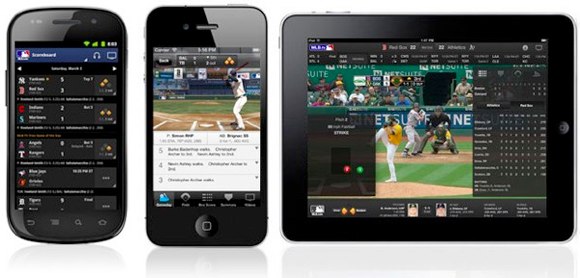
Spending a lot of time on a sickbed last week, one thing helped me get through a bad time: MLB At Bat 2012, revamped for the coming season. Relaunched by MLB Advanced Media with a new pricing scheme for the 2012 season, it’s an essential application for any baseball fan.
If you used it in the past, you’ll love it more; if you’ve never used it, prepare to be dazzled.
The big change this year: it’s actually cheaper to watch and listen to games. In the past, BAM was a little greedy in charging both for MLB.TV service and applications for iPad, iPhone/iPod Touch and Android: springing for an application on multiple devices added up quickly. This year pricing is different: the application is basically free and you’re paying for access to the programming, with the ability to sign up for programming either through the MLB.TV website or within the application.
I ended up installing At Bat 2012 on multiple devices: an iPad, an iPhone and a Kindle Fire, with the ability to access games on AppleTV and Roku devices as well. (Yes, we have a very well-connected household.) The application doesn’t work the same way on all three mobile platforms, especially when setting it up, but that’s a minor issue. Once launched, the interface is pretty simple: you have a selection of games to monitor: you can follow via MLB’s game-day interface or you can launch video broadcast.
There are multiple levels of MLB.TV subscriptions available, including an audio-only $19.95 annual sub that’s actually a little difficult to find on the MLB website. Realistically, there are two main subs for broadcast viewers: a computer-only $109.99 ($19.99/month) sub and a $129.99 ($24.99) premium sub. Unless you really can’t afford the extra $20, go for the premium sub: it includes At Bat 2012 free of charge, supports a whole boatload of connected devices (including Xbox 360, as well as various Internet-connected DVDs and TVs), and gives you a plethora of programming options, including the choice of home, away or Spanish broadcasts (when available). You can overlay radio audio onto a broadcast, or you can launch a mosaic view and monitor four games simultaneously. You can monitor stats in real time, and you can check on fantasy stats as well.
Be warned that MLB.TV won’t provide local broadcasts for whatever market you’re physically in at the moment: if you want to watch a local game, you’ll need to watch it on TV. For some markets, MLB.TV defines blackouts rather liberally: if you’re in Las Vegas, you won’t be able to watch any Los Angeles Angels of Anaheim, San Francisco Giants, Arizona Diamondbacks, Oakland Athletics, Los Angeles Dodgers or San Diego Padres broadcasts. If you’re in Canada, you’ll never see a Toronto Blue Jays game, home or away.
In a changing media landscape, the blackout rule makes less and less sense: if I’m advertising on Yankees games on YES, I really don’t care whether someone is watching via their cable box or a WiFi-connected iPad. Would we see a mass exodus of cable subscribers if MLB.TV broadcast local games? Probably not, as there are far fewer cable cutters in this day and age than the media assumes.
This is a major flaw, and one that limits the attractiveness of the application for many.
But not me. I’m eagerly awaiting the beginning of the regular season, when the true high-def broadcasts start and I can watch them on my new high-def iPad. Should be stunning.–Kevin Reichard
—-
Share your news with the baseball community. Send it to us at editors@augustpublications.com.
Are you a subscriber to the weekly Ballpark Digest newsletter? You can sign up for a free subscription at the Newsletter Signup Page.
Join Ballpark Digest on Facebook and on Twitter!
Follow Ballpark Digest on Google + and add us to your circles!
